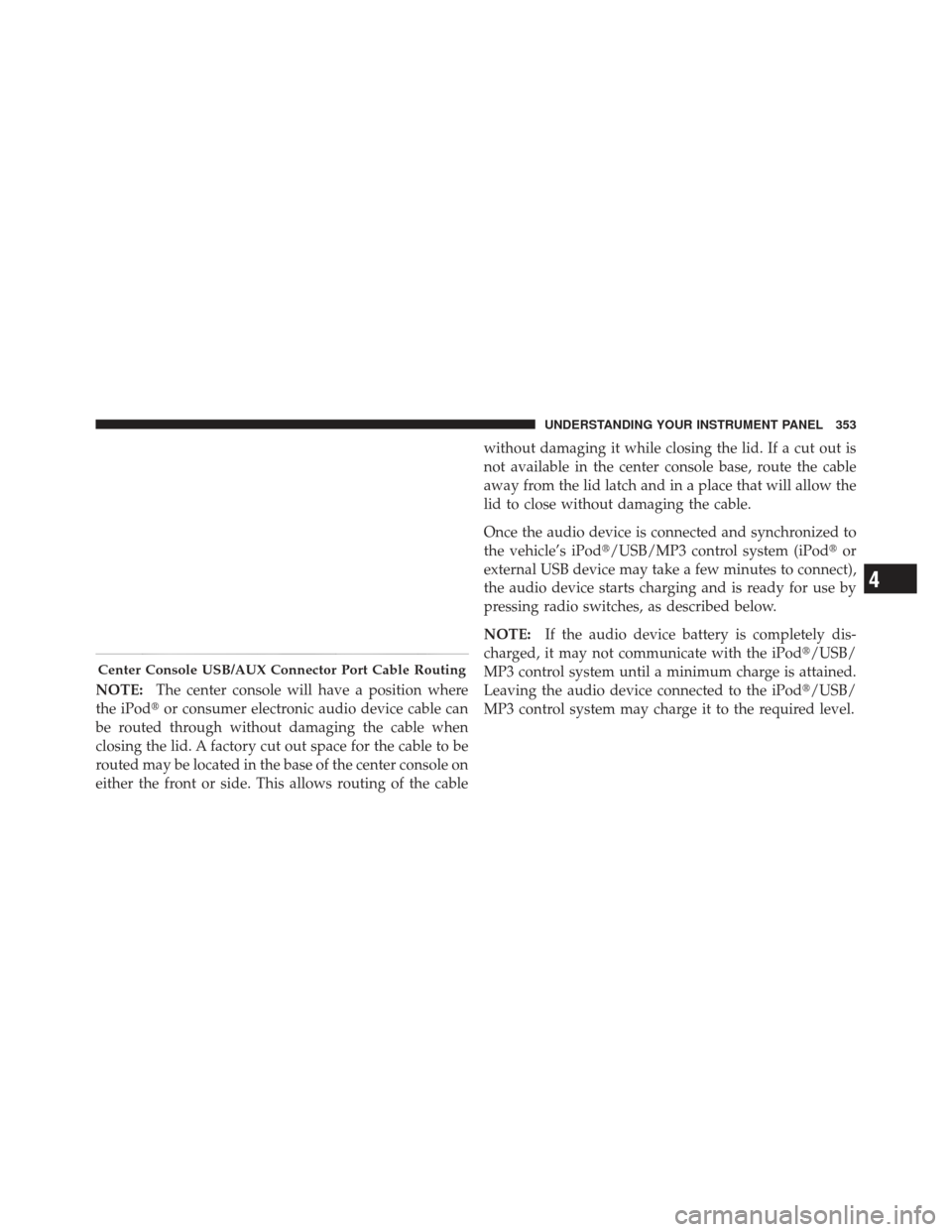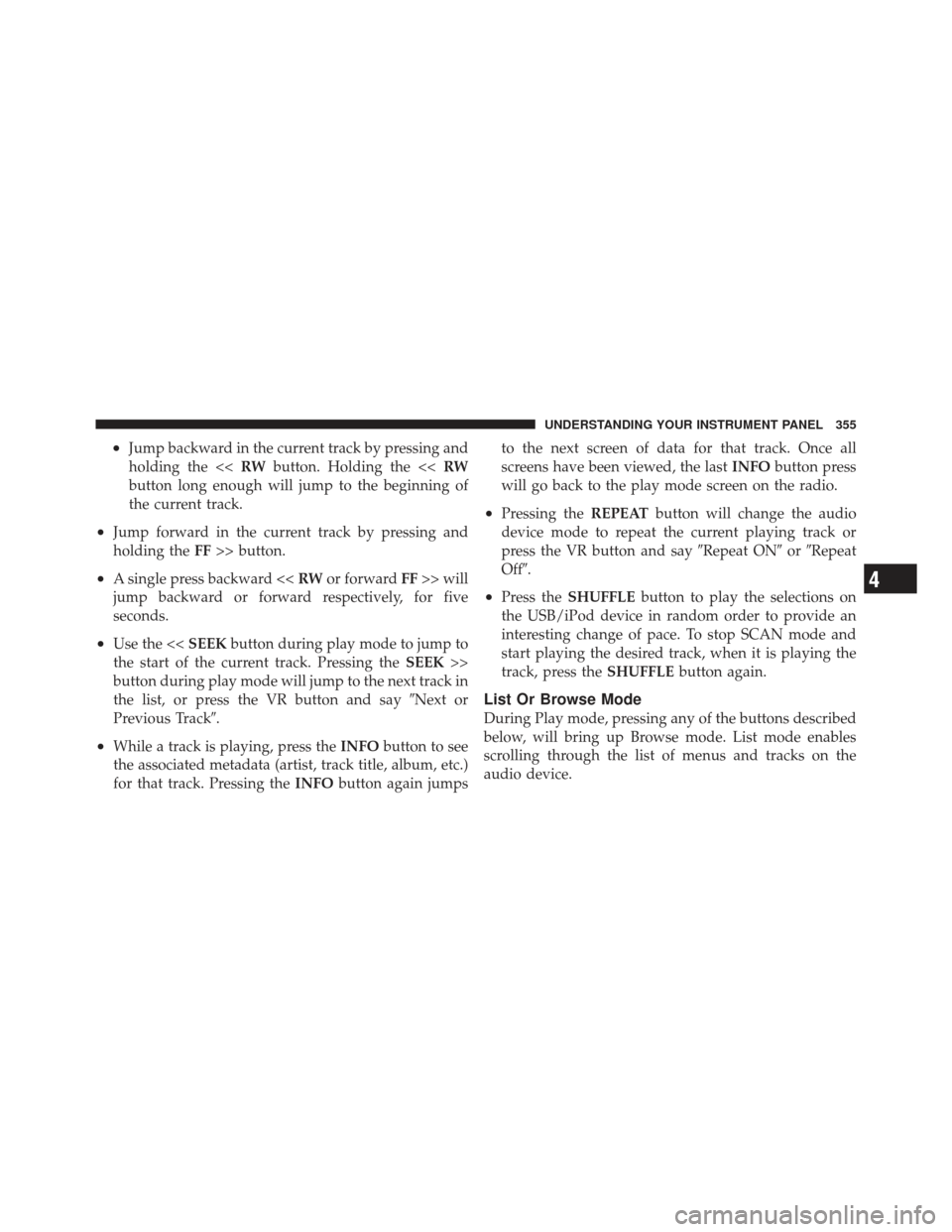Page 292 of 604

WARNING!
Driving a vehicle with the red brake light on is
dangerous. Part of the brake system may have failed.
It will take longer to stop the vehicle. You could have
a collision. Have the vehicle checked immediately.
Vehicles equipped with the Anti-Lock Brake System
(ABS), are also equipped with Electronic Brake Force
Distribution (EBD). In the event of an EBD failure, the
Brake Warning Light will turn on along with the ABS
Light. Immediate repair to the ABS system is required.
Operation of the Brake Warning Light can be checked by
turning the ignition switch from the OFF position to the
ON/RUN position. The light should illuminate for ap-
proximately two seconds. The light should then turn off
unless the parking brake is applied or a brake fault is
detected. If the light does not illuminate, have the light
inspected by an authorized dealer. The light also will turn on when the parking brake is
applied with the ignition switch in the ON/RUN posi-
tion.
NOTE:
This light shows only that the parking brake is
applied. It does not show the degree of brake application.
11. Electronic Stability Control (ESC) OFF Indicator
Light — If Equipped This light indicates the Electronic Stability Con-
trol (ESC) is off.
12. Fuel Gauge
The pointer shows the level of fuel in the fuel tank when
the ignition switch is in the ON/RUN position.
13. Speedometer
Indicates vehicle speed.
290 UNDERSTANDING YOUR INSTRUMENT PANEL
Page 355 of 604

NOTE:The center console will have a position where
the iPod� or consumer electronic audio device cable can
be routed through without damaging the cable when
closing the lid. A factory cut out space for the cable to be
routed may be located in the base of the center console on
either the front or side. This allows routing of the cable without damaging it while closing the lid. If a cut out is
not available in the center console base, route the cable
away from the lid latch and in a place that will allow the
lid to close without damaging the cable.
Once the audio device is connected and synchronized to
the vehicle’s iPod�/USB/MP3 control system (iPod�
or
external USB device may take a few minutes to connect),
the audio device starts charging and is ready for use by
pressing radio switches, as described below.
NOTE: If the audio device battery is completely dis-
charged, it may not communicate with the iPod�/USB/
MP3 control system until a minimum charge is attained.
Leaving the audio device connected to the iPod �/USB/
MP3 control system may charge it to the required level.
Center Console USB/AUX Connector Port Cable Routing
4
UNDERSTANDING YOUR INSTRUMENT PANEL 353
Page 357 of 604

•Jump backward in the current track by pressing and
holding the <
button long enough will jump to the beginning of
the current track.
•Jump forward in the current track by pressing and
holding the FF>> button.
•A single press backward << RWor forward FF>> will
jump backward or forward respectively, for five
seconds.
•Use the << SEEKbutton during play mode to jump to
the start of the current track. Pressing the SEEK>>
button during play mode will jump to the next track in
the list, or press the VR button and say �Next or
Previous Track�.
•While a track is playing, press the INFObutton to see
the associated metadata (artist, track title, album, etc.)
for that track. Pressing the INFObutton again jumps to the next screen of data for that track. Once all
screens have been viewed, the last
INFObutton press
will go back to the play mode screen on the radio.
•Pressing the REPEATbutton will change the audio
device mode to repeat the current playing track or
press the VR button and say �Repeat ON�or�Repeat
Off�.
•Press the SHUFFLE button to play the selections on
the USB/iPod device in random order to provide an
interesting change of pace. To stop SCAN mode and
start playing the desired track, when it is playing the
track, press the SHUFFLEbutton again.
List Or Browse Mode
During Play mode, pressing any of the buttons described
below, will bring up Browse mode. List mode enables
scrolling through the list of menus and tracks on the
audio device.
4
UNDERSTANDING YOUR INSTRUMENT PANEL 355
Page 361 of 604

Pressing the center button will make the radio switch
between the various modes available (AM/FM/SAT/
CD/HDD/AUX, etc.).
The left-hand control is a rocker-type switch with a
pushbutton in the center. The function of the left-hand
control is different depending on which mode you are in.
The following describes the left-hand control operation in
each mode.
Radio Operation
Pressing the top of the switch will “Seek” up for the next
listenable station and pressing the bottom of the switch
will “Seek” down for the next listenable station.
The button located in the center of the left-hand control
will tune to the next preset station that you have pro-
grammed in the radio preset pushbutton.
CD Player
Pressing the top of the switch once will go to the next
track on the CD. Pressing the bottom of the switch once
will go to the beginning of the current track, or to the
beginning of the previous track if it is within one second
after the current track begins to play.
If you press the switch up or down twice, it plays the
second track; three times, it will play the third, etc.
The center button on the left side rocker switch has no
function for a single-disc CD player. However, when a
multiple-disc CD player is equipped on the vehicle, the
center button will select the next available CD in the
player.
4
UNDERSTANDING YOUR INSTRUMENT PANEL 359
Page 369 of 604

Button Descriptions (Applies To Both Hard-keys And
Soft-keys)
1. A/C Button
Press and release to change the current Air Conditioning
(A/C) setting, the indicator illuminates when A/C is ON.
Performing this function will cause the automatic opera-
tion to switch into manual mode and the AUTO indicator
will turn off.
2. Recirculation Button
Press and release to change the current setting, the
indicator illuminates when ON.
3. Blower Control
Blower control is used to regulate the amount of air
forced through the climate system. There are seven
blower speeds available. Adjusting the blower will cause
automatic mode to switch to manual operation. The
speeds can be selected using either hard-keys or soft-keys
as follows:NOTE:
For vehicles equipped with Remote Start, the
climate controls will not function during Remote Start
operation if the blower control is left in the “O” (Off)
position. Blower control should be left in the “ON”
position to allow the climate control to either warm or
cool the vehicle
Hard-key
The blower speed increases as you turn the control
clockwise from the lowest blower setting. The blower
speed decreases as you turn the knob counter-clockwise.
Soft-key
Use the small blower icon to reduce the blower setting
and the large blower icon to increase the blower setting.
Blower can also be selected by pressing the blower bar
area between the icons.
4
UNDERSTANDING YOUR INSTRUMENT PANEL 367
Page 378 of 604

▫Six-Speed Automatic Transmission
(1.4L Turbo Engine Only — Ddct) ......... 389
▫ Gear Ranges ........................ 390
▫ Six-Speed Automatic Transmission
(2.0L And 2.4L Engine Only — 6F24) ...... 399
▫ Gear Ranges ........................ 400
� AutoStick� .......................... 407
▫ Operation ......................... 407
� Driving On Slippery Surfaces ............. 408
▫ Acceleration ........................ 408
▫ Traction ........................... 409
� Driving Through Water ................. 409
▫ Flowing/Rising Water ................. 410
▫ Shallow Standing Water ............... 410 �
Parking Brake ........................ 412
� Power Steering ....................... 414
� Electronic Brake Control System ........... 415
▫ Anti-Lock Brake System (ABS) ........... 415
▫ Brake Assist System (BAS) .............. 418
▫ Traction Control System (TCS) ........... 418
▫ Electronic Roll Mitigation (ERM) ......... 419
▫ Trailer Sway Control (TSC) ............. 420
▫ Hill Start Assist (HSA) ................ 420
▫ Electronic Stability Control (ESC) ......... 423
� Tire Safety Information ................. 427
▫ Tire Markings ....................... 427
▫ Tire Identification Number (TIN) ......... 430
376 STARTING AND OPERATING
Page 387 of 604
Manual Transmission Shift Speeds in MPH (KM/H)
En-
gine Speeds 1 to 2 2 to 3 3 to 4 4 to 5 5 to 6
1.4L, 2.0Land
2.4L En-
gines Accel. 15 (24) 24
(39)34
(55) 47
(76) 56
(90)
Cruise 10 (16) 19 (31)27
(43) 37
(60) 41
(66)
Downshifting
Moving from a high gear down to a lower gear is
recommended to preserve brakes when driving down
steep hills. In addition, downshifting at the right time
provides better acceleration when you desire to resume
speed. Downshift progressively. Do not skip gears to
avoid overspeeding the engine and clutch.
WARNING!
Do not downshift for additional engine braking on a
slippery surface. The drive wheels could lose their
grip, and the vehicle could skid.
CAUTION!
When descending a hill, be very careful to downshift
one gear at a time to prevent overspeeding the engine
which can cause valve damage, and/or clutch disc
damage, even if the clutch pedal is pressed.
5
STARTING AND OPERATING 385
Page 398 of 604

Instrument Cluster Messages
Messages will be displayed in the instrument cluster to
alert the driver when certain unusual conditions occur.
These messages are described below.
MESSAGEDESCRIPTION
GEAR NOT AVAILABLE In AutoStick�mode, the gear selected by the driver is not
available due to a fault condition. See your authorized
dealer for diagnosis and service.
SHIFT NOT ALLOWED The gear position requested by the driver is currently
blocked. This occurs if NEUTRAL is requested while moving
(with the throttle opened), if REVERSE is requested while
moving (at 6 mph [10 km/h] or faster), if DRIVE is re-
quested while moving backwards (at 6 mph [10 km/h] or
faster), or if 3rd gear or higher is requested at a stop. Make
sure the vehicle is stopped before engaging DRIVE or RE-
VERSE.
SHIFT TO NEUTRAL – THEN D or R The transmission has shifted itself into NEUTRAL (due to a fault condition, or overheat due to excessive idling when
stopped in DRIVE with the brakes released), but the shift
396 STARTING AND OPERATING